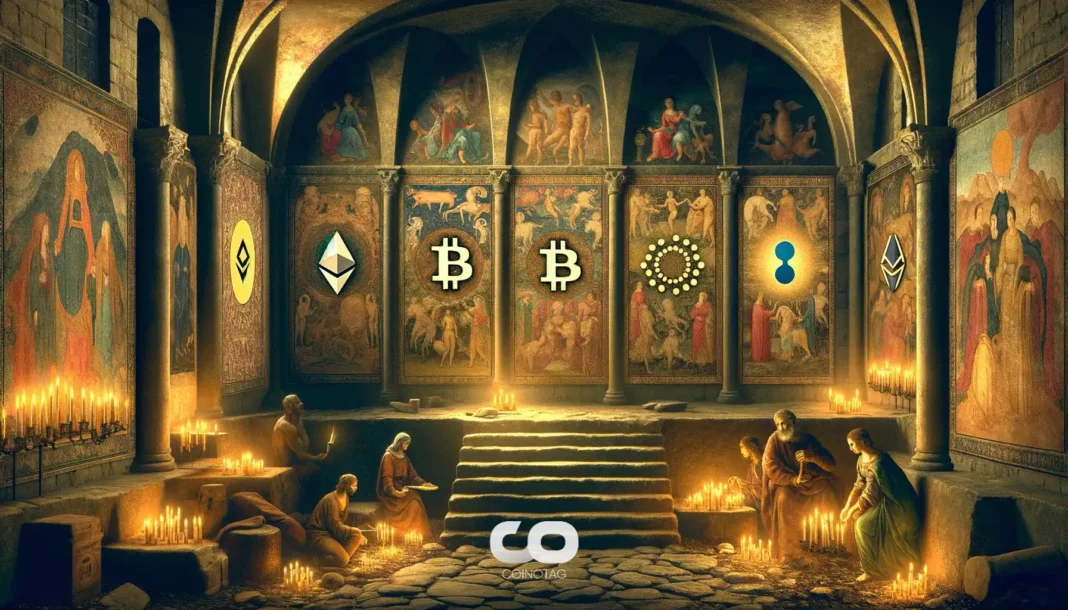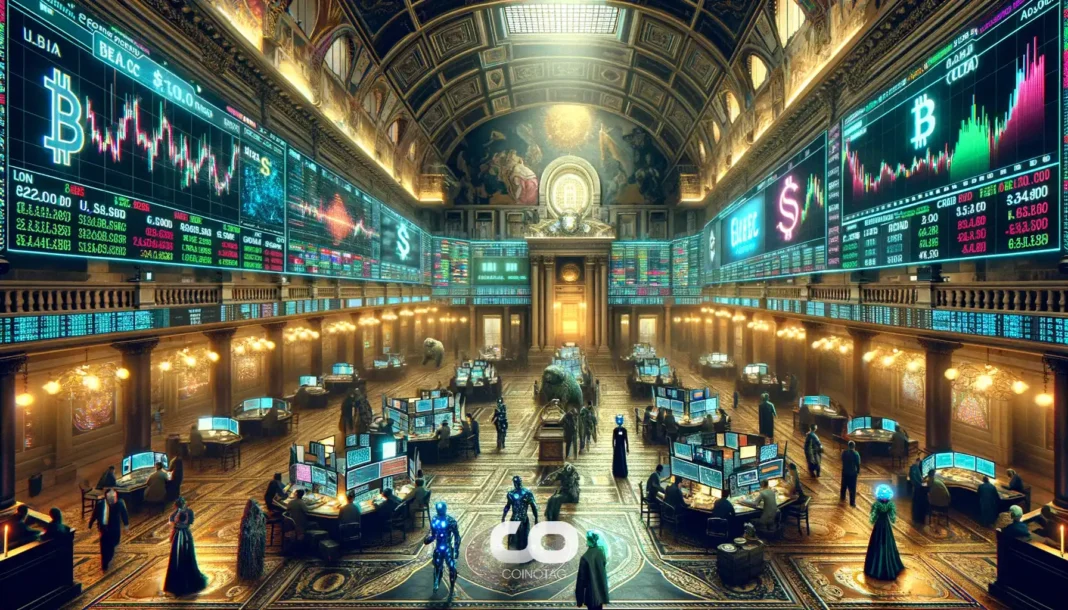| COINOTAG recommends • Exchange signup |
| 💹 Trade with pro tools |
| Fast execution, robust charts, clean risk controls. |
| 👉 Open account → |
| COINOTAG recommends • Exchange signup |
| 🚀 Smooth orders, clear control |
| Advanced order types and market depth in one view. |
| 👉 Create account → |
| COINOTAG recommends • Exchange signup |
| 📈 Clarity in volatile markets |
| Plan entries & exits, manage positions with discipline. |
| 👉 Sign up → |
| COINOTAG recommends • Exchange signup |
| ⚡ Speed, depth, reliability |
| Execute confidently when timing matters. |
| 👉 Open account → |
| COINOTAG recommends • Exchange signup |
| 🧭 A focused workflow for traders |
| Alerts, watchlists, and a repeatable process. |
| 👉 Get started → |
| COINOTAG recommends • Exchange signup |
| ✅ Data‑driven decisions |
| Focus on process—not noise. |
| 👉 Sign up → |
-
The ongoing discourse surrounding NFTs and creator royalties has stirred significant debate, especially following SEC Commissioner Hester Peirce’s latest remarks.
-
Many experts, including legal professionals, argue that Peirce’s comments clarify rather than change the regulatory landscape, asserting that royalties do not equate to investment securities.
-
According to Oscar Franklin Tan, the interpretation of creator royalties as securities is fundamentally flawed, emphasizing that the SEC has never prohibited such arrangements.
This article explores Hester Peirce’s comments on NFTs and royalties, analyzing their implications for creators and the evolving regulatory landscape.
Understanding NFT Royalties and SEC Regulations
Commissioner Hester Peirce recently provided valuable insights into the world of nonfungible tokens (NFTs) and their associated royalties, contending that many NFTs do not fall under federal securities laws. This perspective holds significant implications for creators and the NFT marketplace.
Peirce stated that NFTs allowing for creator royalty payments do not automatically designate these tokens as securities. Unlike traditional investments such as stocks, NFTs are programmable and can yield financial benefits without creating an obligation for the creator to share profits or interests in a business enterprise.
“Much like how streaming platforms reward creators whenever their content is used, NFTs can enable artists to realize value appreciation after initial sales,” explained Peirce. Beyond the SEC’s purview, these assets represent innovative avenues for creator monetization.
| COINOTAG recommends • Professional traders group |
| 💎 Join a professional trading community |
| Work with senior traders, research‑backed setups, and risk‑first frameworks. |
| 👉 Join the group → |
| COINOTAG recommends • Professional traders group |
| 📊 Transparent performance, real process |
| Spot strategies with documented months of triple‑digit runs during strong trends; futures plans use defined R:R and sizing. |
| 👉 Get access → |
| COINOTAG recommends • Professional traders group |
| 🧭 Research → Plan → Execute |
| Daily levels, watchlists, and post‑trade reviews to build consistency. |
| 👉 Join now → |
| COINOTAG recommends • Professional traders group |
| 🛡️ Risk comes first |
| Sizing methods, invalidation rules, and R‑multiples baked into every plan. |
| 👉 Start today → |
| COINOTAG recommends • Professional traders group |
| 🧠 Learn the “why” behind each trade |
| Live breakdowns, playbooks, and framework‑first education. |
| 👉 Join the group → |
| COINOTAG recommends • Professional traders group |
| 🚀 Insider • APEX • INNER CIRCLE |
| Choose the depth you need—tools, coaching, and member rooms. |
| 👉 Explore tiers → |
The Legal Landscape Surrounding NFTs
As analyzed by legal expert Oscar Franklin Tan, Peirce’s clarification sheds light on how current U.S. securities law approaches creator compensation through royalties. He argues that securities regulations primarily focus on investments, which contrasts with the nature of NFT royalty payments.
“Royalties are not synonymous with investment income but represent a form of business earnings,” Tan noted. This distinction is crucial since the SEC does not regulate payment models that adequately compensate creators.
| COINOTAG recommends • Exchange signup |
| 📈 Clear interface, precise orders |
| Sharp entries & exits with actionable alerts. |
| 👉 Create free account → |
| COINOTAG recommends • Exchange signup |
| 🧠 Smarter tools. Better decisions. |
| Depth analytics and risk features in one view. |
| 👉 Sign up → |
| COINOTAG recommends • Exchange signup |
| 🎯 Take control of entries & exits |
| Set alerts, define stops, execute consistently. |
| 👉 Open account → |
| COINOTAG recommends • Exchange signup |
| 🛠️ From idea to execution |
| Turn setups into plans with practical order types. |
| 👉 Join now → |
| COINOTAG recommends • Exchange signup |
| 📋 Trade your plan |
| Watchlists and routing that support focus. |
| 👉 Get started → |
| COINOTAG recommends • Exchange signup |
| 📊 Precision without the noise |
| Data‑first workflows for active traders. |
| 👉 Sign up → |
Tan emphasized that the SEC has not discouraged contracts permitting royalty payments from secondary sales, a scenario that has been misrepresented in various media outlets. He expressed the need for thoughtful consideration of how traditional legal principles apply to new digital assets, suggesting that if a similar agreement could occur outside of the blockchain, then it should not invite regulatory scrutiny.
Compliance and Regulatory Calls from NFT Marketplaces
In contrast to the clarity surrounding creator royalties, NFT marketplaces face a more complicated regulatory environment. OpenSea, a leading NFT trading platform, attracted SEC attention and received a Wells notice in August 2024. This document indicated that certain NFTs sold on the platform could potentially qualify as unregistered securities.
| COINOTAG recommends • Traders club |
| ⚡ Futures with discipline |
| Defined R:R, pre‑set invalidation, execution checklists. |
| 👉 Join the club → |
| COINOTAG recommends • Traders club |
| 🎯 Spot strategies that compound |
| Momentum & accumulation frameworks managed with clear risk. |
| 👉 Get access → |
| COINOTAG recommends • Traders club |
| 🏛️ APEX tier for serious traders |
| Deep dives, analyst Q&A, and accountability sprints. |
| 👉 Explore APEX → |
| COINOTAG recommends • Traders club |
| 📈 Real‑time market structure |
| Key levels, liquidity zones, and actionable context. |
| 👉 Join now → |
| COINOTAG recommends • Traders club |
| 🔔 Smart alerts, not noise |
| Context‑rich notifications tied to plans and risk—never hype. |
| 👉 Get access → |
| COINOTAG recommends • Traders club |
| 🤝 Peer review & coaching |
| Hands‑on feedback that sharpens execution and risk control. |
| 👉 Join the club → |
However, following recent developments, OpenSea CEO Devin Finzer announced the closure of the SEC investigation, which he characterized as a significant victory for the broader NFT community. Yet, the uncertainty regarding regulatory oversight remains.
In light of this uncertainty, OpenSea’s legal team urged the SEC to establish clear guidelines, indicating that NFT marketplaces should not be classified as brokerages under U.S. securities law. They contended that these platforms merely facilitate transactions without acting as intermediaries in the traditional sense.
Potential Implications for the Future of NFTs
The future of NFTs hinges on how regulators address the complexities of digital asset classification. With Peirce’s comments, the conversation shifts towards a more explicit understanding of the relationship between creator royalties and securities law.
As the NFT landscape evolves, it is imperative for regulators and stakeholders to establish parameters that promote innovation while ensuring consumer protection. This approach will foster a balanced regulatory environment that sustains artistic freedom and financial viability for creators and marketplaces alike.
| COINOTAG recommends • Exchange signup |
| 📈 Clear control for futures |
| Sizing, stops, and scenario planning tools. |
| 👉 Open futures account → |
| COINOTAG recommends • Exchange signup |
| 🧩 Structure your futures trades |
| Define entries & exits with advanced orders. |
| 👉 Sign up → |
| COINOTAG recommends • Exchange signup |
| 🛡️ Control volatility |
| Automate alerts and manage positions with discipline. |
| 👉 Get started → |
| COINOTAG recommends • Exchange signup |
| ⚙️ Execution you can rely on |
| Fast routing and meaningful depth insights. |
| 👉 Create account → |
| COINOTAG recommends • Exchange signup |
| 📒 Plan. Execute. Review. |
| Frameworks for consistent decision‑making. |
| 👉 Join now → |
| COINOTAG recommends • Exchange signup |
| 🧩 Choose clarity over complexity |
| Actionable, pro‑grade tools—no fluff. |
| 👉 Open account → |
Conclusion
In summary, Hester Peirce’s comments signify a pivotal moment in the regulatory treatment of NFTs and their associated royalty structures. As legal expert Oscar Franklin Tan asserts, the continued dialogue on this subject underscores the importance of adapting traditional frameworks to accommodate emerging technologies. With clarity from regulators, creators may find new ways to monetize their work, ensuring that the NFT space remains a vibrant avenue for artistic expression and innovation.
| COINOTAG recommends • Members‑only research |
| 📌 Curated setups, clearly explained |
| Entry, invalidation, targets, and R:R defined before execution. |
| 👉 Get access → |
| COINOTAG recommends • Members‑only research |
| 🧠 Data‑led decision making |
| Technical + flow + context synthesized into actionable plans. |
| 👉 Join now → |
| COINOTAG recommends • Members‑only research |
| 🧱 Consistency over hype |
| Repeatable rules, realistic expectations, and a calmer mindset. |
| 👉 Get access → |
| COINOTAG recommends • Members‑only research |
| 🕒 Patience is an edge |
| Wait for confirmation and manage risk with checklists. |
| 👉 Join now → |
| COINOTAG recommends • Members‑only research |
| 💼 Professional mentorship |
| Guidance from seasoned traders and structured feedback loops. |
| 👉 Get access → |
| COINOTAG recommends • Members‑only research |
| 🧮 Track • Review • Improve |
| Documented PnL tracking and post‑mortems to accelerate learning. |
| 👉 Join now → |







